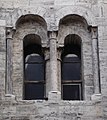Divi Blasii
This article needs additional citations for verification. (September 2012) |
| Divi Blasii | |
|---|---|
| St. Blaise's | |
Divi-Blasii-Kirche | |
 Side view, facing southeast | |
 Divi Blasii Location in Germany | |
| Coordinates: 51°12′26″N 10°27′30″E / 51.20722°N 10.45833°E | |
| Location | Mühlhausen, Thuringia |
| Country | Germany |
| Denomination | Lutheran |
| Previous denomination | Roman Catholic |
| History | |
| Status | Church |
| Founded | Middle Ages |
| Founder(s) | Teutonic Knights |
| Dedication | St. Blaise |
| Associated people | Johann Sebastian Bach |
| Architecture | |
| Functional status | Parish church |
| Architectural type | Hall church |
| Style | Gothic |
| Years built | 13th/14th century |
| Groundbreaking | about 1276 |
| Specifications | |
| Number of spires | 2 |
| Bells | 3 |
| Tenor bell weight | about 5.5 t |
Divi Blasii is a Gothic church in the Thuringian town of Mühlhausen, central Germany. Besides St. Mary's, it is one of Mühlhausen's two principal churches.
Teutonic Knights founded the church in the Middle Ages. It was named after Saint Blaise, and is also known as St Blasius or St. Blasius's. Since the Reformation it is mostly known as Divi Blasii (Latin for “of Blaise the Divine”) or Blasius Church.
It is a hall church with nave and side aisles of approximately equal height. The Gothic architecture of the church is said to have been an influence on the design of Brooklyn Bridge by John A. Roebling who grew up in Mühlhausen.
Side view, facing west
Interior view

Organ
The two spires, looking northeast
Southern spire
Detail of the southern spire socket

Rose window at the north transept
Rose window, looking south
Organ[]
Johann Sebastian Bach was organist of the church in 1707/08. Although he did not stay in the town for long, the authorities recognised his musical abilities, and made him the consultant for rebuilding the organ. This involved replacing an old two-manual instrument.
Bach's specifications for the new organ have survived: he required three manuals, pedals, and 37 stops.[1] The project was undertaken by the respected local organ builder Johann Friedrich Wender. Wender's previous work included a two-manual instrument at the New Church in Arnstadt (today known as the Bach Church, with which Bach was familiar as he was employed there before coming to Mühlhausen.[2] The Mühlhausen organ was completed in 1709, by which time Bach had been succeeded as organist by his cousin Johann Friedrich Bach,[1] but there is evidence that Bach returned to the town to inaugurate the instrument.
Wender's organ of 1709 has not survived. However, the present instrument was built according to Bach's specifications. Albert Schweitzer, a leading figure in the Organ reform movement, acted as consultant on the reconstruction, which took place in the 1950s.[3]
Tourist information[]
The church is currently closed during the winter months.
References[]
- ^ Jump up to: a b "Muhlhausen". Bach Cantatas Website. Retrieved 3 December 2014.
- ^ "Johann Friedrich Wender (Organ Builder)". Retrieved 23 September 2012.
- ^ Hill, John. "The Church of Blaise the Divine (Divi-Blasii-Kirche)". Archived from the original on 14 November 2007. Retrieved 19 September 2012.
External links[]
| Wikimedia Commons has media related to Divi Blasii, Mühlhausen. |
- Mühlhausen
- Protestant churches in Thuringia
- Gothic hall churches in Germany
- Lutheran churches converted from Roman Catholicism
- Buildings and structures in Unstrut-Hainich-Kreis








